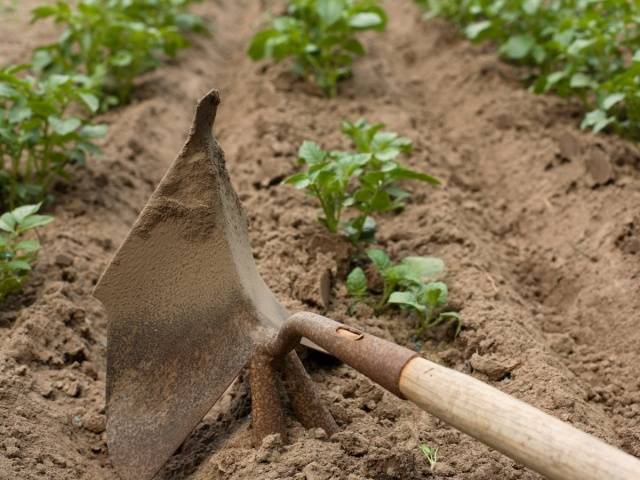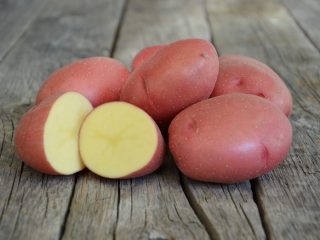Content
Krona is a young but promising potato variety from Germany that can be grown in any corner of the country. It is undemanding to agricultural technology and consistently produces good harvests, for which he is highly appreciated. Crohn's potatoes can be recommended to both beginning gardeners and summer residents who, due to circumstances, cannot often visit their plots.
In the article, we will consider a detailed description and photo of Crohn's potatoes, give it a description and read its reviews. We will also analyze the features of cultivation and agricultural technology.
Origin
The Kron potato was created by German breeders of the German company Bavaria-Saat GBR through many years of selection. This is an agrotechnical enterprise that develops new varieties and propagates them.
In 2015, the German hybrid was included in the Russian state register. Since potatoes of this variety tolerate temperature fluctuations and lack of moisture well, they began to be actively propagated and planted in many regions of the country. It also began to quickly gain popularity in Europe.
Characteristic
Potato Krona – A hardy, mid-early ripening variety that easily tolerates drought. It has a high yield and can withstand storage, transportation and packaging.
Description of the bush
Crohn's potato bushes are medium spreading and erect. The height of the stems is on average 50 cm. The leaves are medium in size, have a matte surface with clear veins, slightly wavy edges and a rich, green color.
Small corollas with large, snow-white flowers form at the tops of the stems. They quickly fall off and few berries are produced. One bush brings 10-15 tubers, since it forms a powerful root system.
Description of tubers
Medium sized crown tubers, diameter from 4 to 7 cm and weight from 75 to 135 g. They have an oval shape and a smooth surface with inconspicuous, small eyes. The pulp is juicy and yellow. The peel is thin, monochromatic, lemon-colored.
The taste of potatoes of this variety is rich and not watery. Contains a moderate amount of starch, an average of 13%. That's why When cut, the tubers retain their color and do not darken. Potatoes are characterized by a high content of nutrients, carotene, proteins and fiber.
Advantages and disadvantages
Krona potatoes are very popular among gardeners in many countries. This is due to the fact that this is one of the most unpretentious varieties that has many advantages:
- Suitable for growing in almost all climatic zones. It can be planted in both hot and cold regions.
- Tolerates drought and increased temperatures.
- Undemanding to soil composition. Potatoes can grow in any type of soil.
- Almost all tubers have high commercial qualities. There are few small and substandard potatoes.
- High resistance to disease, destructive for most potato varieties. The crown is not affected by late blight, potato cancer, scab and rot.
- Good keeping quality. During long-term storage, 96% of the harvest is preserved.
- During transportation, root crops are not damaged or darkened and retain their original appearance.
- The seed material retains varietal qualities and does not degenerate.
The root vegetable is ideal for cooking frozen vegetable mixtures and French fries. Cooks fry it, stuff it and bake it. When cooked, the vegetable does not soften and retains its shape, so it is not suitable for making purees.
There are few disadvantages to this variety of potatoes. When growing crops on dense and rocky soil, some tubers may take on an irregular shape. And if there is excess moisture in the soil and frequent watering, the potatoes can crack or rot. But this can be avoided by providing the potatoes with minimal and rational care.
Productivity and ripening time
Krona potatoes are a mid-early variety. From the planting stage to tuber ripening takes from 100 to 110 days, and from the moment of germination - 80-90 days.
Planting this variety brings a bountiful harvest. Its size depends on the climate and weather conditions of the growing region. Average per hectare you can get 54 tons of potatoes. Maximum yield - 65 t/ha.
Planting potatoes
Even though Crohn's potatoes are easy to grow, it takes some effort to enjoy tasty potatoes. Compliance with the peculiarities and rules of agricultural technology guarantees a rich harvest.
Site selection and processing
It is better to choose a site for Krona potatoes on the southern and southwestern slopes. They are good illuminated by the sun's rays, and the earth warms up better on them.
Culture prefers loose and slightly acidic soil. You can determine acidity by plants: chamomile, wheatgrass, clover and dandelion usually grow in such soil. Potatoes of this variety grow well on sandy, chernozem and loamy soils.
If groundwater lies nearby, then vegetable plantings should be placed on ridges or ridges. The best predecessors of potatoes: cabbage, legumes, winter crops, root vegetables. You should not plant potatoes in an area where nightshade crops grew. When digging, you can add a small amount of organic fertilizer to the soil. The best is rotted horse manure.
Tuber preparation
A month before planting potatoes in the soil, you need to prepare planting material. For this you need select healthy medium-sized tubers, weighing from 50 to 80 g. To prevent diseases, the vegetable can be dipped in a solution of copper sulfate. After drying, treat with a growth stimulator.
The next stage is germination. To do this, lay out the planting potatoes in boxes in 1-2 layers and put them in a bright room. The first 7 days maintain the temperature at 20-22OC, then reduce it to 7-8OC and keep the potatoes for another 4 weeks. Periodically it is sprayed with water and turned over. The vegetable should acquire a dark green color. When are they formed sprouts are 10-15 mm long, potatoes can be planted.
Landing rules
After preparing the planting material, you can begin planting it. In this case, it is necessary to take into account some agrotechnical features of potatoes of the Krona variety:
- tubers should plant at a distance of 25 to 30 cm;
- between the rows need to leave not less than 65 cm;
- The potato planting depth should be 4-5 cm.
If the area allows, then the distances between the holes and beds can be increased. This makes caring for potatoes easier.
Features of care
The crown does not require special care. With minimal effort you can grow good potatoes of this variety. To obtain maximum yield, hilling, removal weed, timely moistening of the soil and fertilizing.
Watering
Potato Crohn's tolerates short-term drought and lack of water well. But in order to get a high-quality and abundant harvest, moderate watering is recommended during the period of bud formation. If there is a lack of moisture, the plant does not die, but a large number of small potatoes may form.
On average for the entire season requires 2-3 waterings. It is necessary to avoid getting water on the leaves, as this can contribute to the appearance of late blight.
Hilling
The first hilling should be carried out when the height of the crown shoots will reach 15-18 cm. The event replaces both loosening and weeding. And in unstable climatic conditions it protects seedlings from returning spring frosts.
The second hilling is performed 15-20 days after the first. Sometimes this is enough.But if the grown bushes begin to fall apart and tubers emerge from the soil, the procedure should be repeated.
It is recommended to hill up bushes after rain, since wet soil does not crumble. This promotes the appearance of additional shoots, on which tubers then form.
Top dressing
Potato variety Krona does not need frequent feeding. But moderate application of various fertilizers will improve the quality of tubers and bring a good increase in yield.
Organic is best used rotted manure and wood ash. From minerals - phosphorus-potassium fertilizers.
Disease Prevention
The crown has good immunity to many diseases that can easily affect other potato varieties. Plant not susceptible to rot, common scab, potato cancer and viral infections. Green mass and tubers are rarely affected by late blight.
To protect potatoes before planting, root crops must be treated Bordeaux mixture or copper sulfate solution. The soil needs to be watered with a disinfectant. It is advisable to change the site for planting this crop every year.
Young leaves and stems can be parasitized by: aphids, Colorado potato beetles, spider mites and cicadas. To protect potatoes from them, it is necessary remove weeds in a timely manner and mulch the soil. In case of massive damage, the plant needs to be treated with insecticides, which must be applied before flowering begins.
Reviews from gardeners
Conclusion
Krona potatoes are a new and promising variety that can be grown both for individual consumption and on an industrial scale. It is ideal for transportation, storage and packaging. Even an inexperienced gardener can grow potatoes of this variety, as they are undemanding in care.














